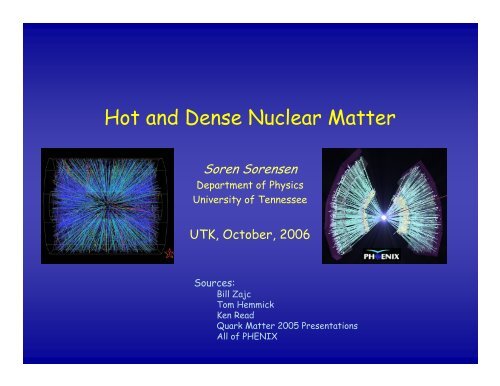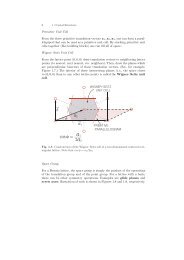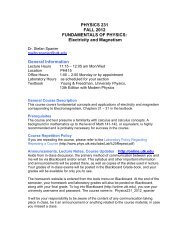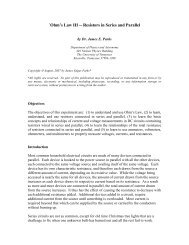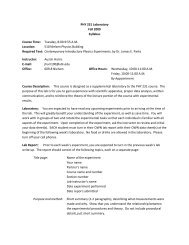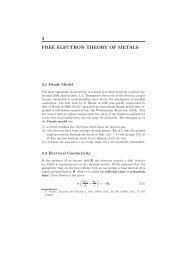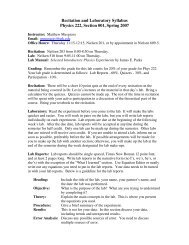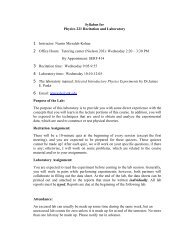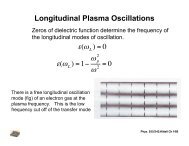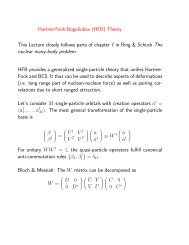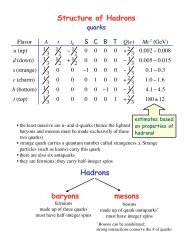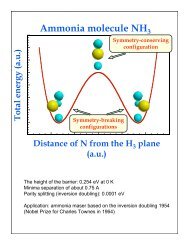Hot and Dense Nuclear Matter - Department of Physics and Astronomy
Hot and Dense Nuclear Matter - Department of Physics and Astronomy
Hot and Dense Nuclear Matter - Department of Physics and Astronomy
Create successful ePaper yourself
Turn your PDF publications into a flip-book with our unique Google optimized e-Paper software.
<strong>Hot</strong> <strong>and</strong> <strong>Dense</strong> <strong>Nuclear</strong> <strong>Matter</strong><br />
Soren Sorensen<br />
<strong>Department</strong> <strong>of</strong> <strong>Physics</strong><br />
University <strong>of</strong> Tennessee<br />
UTK, October, 2006<br />
Sources:<br />
Bill Zajc<br />
Tom Hemmick<br />
Ken Read<br />
Quark <strong>Matter</strong> 2005 Presentations<br />
All <strong>of</strong> PHENIX
The St<strong>and</strong>ard Model<br />
<strong>Hot</strong> <strong>and</strong> <strong>Dense</strong> <strong>Nuclear</strong> matter 2
Quark Confinement<br />
What happens if we try to “free” a quark from it’s partner?<br />
A typical meson<br />
The meson is being<br />
stretched to separate the<br />
quarks.<br />
The “spring” energy between<br />
the quarks is eventually so<br />
high that a new quark pair is<br />
created -> two new mesons<br />
are formed.<br />
No free quarks. The quarks are confined to be inside hadrons.<br />
<strong>Hot</strong> <strong>and</strong> <strong>Dense</strong> <strong>Nuclear</strong> matter 3
Is there another way we can “free”<br />
the quarks?<br />
Normal <strong>Nuclear</strong> <strong>Matter</strong><br />
Quark Gluon Plasma<br />
Increasing density or temperature<br />
This figure <strong>and</strong> several others in this talk are copied from<br />
“Gauge Field Theories” by Mike Guidry<br />
<strong>Hot</strong> <strong>and</strong> <strong>Dense</strong> <strong>Nuclear</strong> matter 4
Phase Diagram for <strong>Nuclear</strong> <strong>Matter</strong><br />
Partonic <strong>Matter</strong><br />
<strong>Hot</strong> <strong>and</strong> <strong>Dense</strong> <strong>Nuclear</strong> matter 5
What kind <strong>of</strong> phase transition?<br />
<strong>Hot</strong> <strong>and</strong> <strong>Dense</strong> <strong>Nuclear</strong> matter 6
<strong>Hot</strong> <strong>and</strong> <strong>Dense</strong> <strong>Nuclear</strong> matter 7
QGP connection to the Big Bang<br />
<strong>Hot</strong> <strong>and</strong> <strong>Dense</strong> <strong>Nuclear</strong> matter 8
How to create a Quark Gluon Plasma in the lab?<br />
A Little “Big Bang”<br />
Our best guess: Collisions between large atomic nuclei at the highest possible energies<br />
Low energy collisions create no QG plasma (we have tried!)<br />
High energy collisions will.<br />
Animation by Jeffery Mitchell. VNI model by Klaus Kinder-Geiger <strong>and</strong> Ron Longacre, Brookhaven National Laboratory<br />
<strong>Hot</strong> <strong>and</strong> <strong>Dense</strong> <strong>Nuclear</strong> matter 9
RHIC’s Experiments<br />
STA<br />
R<br />
<strong>Hot</strong> <strong>and</strong> <strong>Dense</strong> <strong>Nuclear</strong> matter 10
Evolution <strong>of</strong> Heavy Ion Collisions<br />
Preequilibrium<br />
Thermalization<br />
QGP<br />
phase?<br />
Mixed<br />
Phase<br />
Hadronization<br />
Expansion<br />
T < 0<br />
0.1 fm/c<br />
~ 1 fm/c<br />
3-4 fm/c<br />
8–10 fm/c<br />
10 – 20 fm/c<br />
γ, γ∗→ e + e - , μ + μ −<br />
Hard processes (early<br />
stages): Real <strong>and</strong> virtual<br />
photons, leptons, high p T<br />
particles.<br />
π, K, p, n, φ, Λ, Δ, Ξ, Ω, d,…<br />
S<strong>of</strong>t hadrons reflect<br />
medium properties later<br />
in the collision after<br />
hadronization (chemical<br />
freeze-out).<br />
<strong>Hot</strong> <strong>and</strong> <strong>Dense</strong> <strong>Nuclear</strong> matter 11
Late Stage Hadro-Chemistry<br />
Preequilibrium<br />
Therma-<br />
Lization<br />
QGP<br />
phase?<br />
Mixed<br />
Phase<br />
Hadronization<br />
Expansion<br />
T =<br />
0.1 fm/c<br />
~ 1 fm/c<br />
3-4 fm/c<br />
8–10 fm/c<br />
10 – 20 fm/c<br />
π, K, p, n, φ, Λ, Δ, Ξ, Ω, d,…<br />
Relative Hadron<br />
Abundances –<br />
Hadro Chemistry<br />
<strong>Hot</strong> <strong>and</strong> <strong>Dense</strong> <strong>Nuclear</strong> matter 12
Late stage hadrochemistry<br />
• Assume all distributions described by one temperature T <strong>and</strong> one<br />
(baryon) chemical potential μ<br />
(Chemical Equilibrium):<br />
• One ratio (e.g., ⎯p-bar / p ) determines μ / T :<br />
• A second ratio (e.g., K / π ) provides T μ<br />
• Then predict all other hadronic yields <strong>and</strong> ratios:<br />
−( E −μ)/ T 3<br />
dn ~ e d p<br />
− ( E + μ)/<br />
T<br />
p e<br />
= = e<br />
−( E −μ)/<br />
T<br />
p e<br />
−2 μ / T<br />
<strong>Hot</strong> <strong>and</strong> <strong>Dense</strong> <strong>Nuclear</strong> matter 13
•<br />
What do we learn from<br />
Hadro Chemical Thermodynamics<br />
– Beautiful systematics from many<br />
energies <strong>of</strong> freeze-out conditions<br />
– Does not necessarily indicate<br />
• QGP formation <strong>and</strong> Deconfinement<br />
– But …<br />
• Relaxation time <strong>of</strong> Ω (sss)<br />
– Hadronic state: Ω (sss) reaches<br />
chemical equilibrium only after 40-50<br />
fm/c<br />
RHIC<br />
– Partonic state: (sss) reaches chemical<br />
equilibrium in 1-2 fm/c<br />
– Freeze-out happens after max 10-20<br />
fm/c<br />
– Indication that the chemical equilibrium<br />
is reached in a partonic phase.<br />
<strong>Hot</strong> <strong>and</strong> <strong>Dense</strong> <strong>Nuclear</strong> matter 14
Signals from High Density State<br />
Preequilibrium<br />
Therma-<br />
Lization<br />
QGP<br />
phase?<br />
Mixed<br />
Phase<br />
Hadronization<br />
Expansion<br />
T =<br />
0.1 fm/c<br />
~ 1 fm/c<br />
3-4 fm/c<br />
8–10 fm/c<br />
10 – 20 fm/c<br />
High Density Partonic<br />
State Signatures:<br />
Jet Quenching<br />
<strong>Hot</strong> <strong>and</strong> <strong>Dense</strong> <strong>Nuclear</strong> matter 15
Transverse Dynamics<br />
p<br />
p T<br />
θ<br />
Q. How to probe the deep interior <strong>and</strong> the earliest phases <strong>of</strong> the collision?<br />
A. By measuring “hard scatterings” at large p T<br />
“transverse momenta”<br />
<strong>Hot</strong> <strong>and</strong> <strong>Dense</strong> <strong>Nuclear</strong> matter 16
Hard Scattered Partons (= Probes)<br />
• Hard scatterings in nucleonnucleon<br />
collisions produce<br />
jets <strong>of</strong> particles.<br />
schematic view <strong>of</strong> jet production<br />
hadrons<br />
leading<br />
particle<br />
q<br />
jet<br />
• In particular, the jets are<br />
great probes <strong>of</strong> the medium<br />
they traverse<br />
hadrons<br />
jet<br />
leading particle<br />
q<br />
<strong>Hot</strong> <strong>and</strong> <strong>Dense</strong> <strong>Nuclear</strong> matter 17
Calibrated Probes<br />
• Extensive in situ measurements in (simple) p+p collisions at RHIC<br />
– Calibrated probes<br />
– Supported by well-established theory (perturbative Quantum Chromo<br />
Dynamics - pQCD)<br />
Produced pions<br />
Produced photons<br />
<strong>Hot</strong> <strong>and</strong> <strong>Dense</strong> <strong>Nuclear</strong> matter 18
Schematically (Photons)<br />
The scattered direct photons always emerge undisturbed,<br />
because they do not interact via <strong>Nuclear</strong> Forces (Strong<br />
Interactions)<br />
<strong>Hot</strong> <strong>and</strong> <strong>Dense</strong> <strong>Nuclear</strong> matter 19
Direct Photon Spectra in Au+Au<br />
• Now have a calibrated<br />
probe (note agreement<br />
<strong>of</strong> data <strong>and</strong> theory)<br />
• that works in the<br />
complex environment <strong>of</strong><br />
two nuclei (Au+Au )<br />
colliding at high energies<br />
• N binary or N collision scaling<br />
works!<br />
<strong>Hot</strong> <strong>and</strong> <strong>Dense</strong> <strong>Nuclear</strong> matter 20
Jet Quenching<br />
The jet has to make its way out through the hot <strong>and</strong> dense medium<br />
Energy loss (stopping power) depends<br />
critically on type <strong>of</strong> medium:<br />
Hadronic Medium: ~ 0.2 - 0.4 GeV/fm<br />
Partonic Medium: ~ 2 – 3 GeV/fm<br />
<strong>Hot</strong> <strong>and</strong> <strong>Dense</strong> <strong>Nuclear</strong> matter 21
Discovery <strong>of</strong> Strong Suppression<br />
peripheral<br />
N coll<br />
= 12.3 ± 4.0<br />
central<br />
N coll<br />
= 975 ± 94<br />
→<br />
Scaling <strong>of</strong> calibrated probe works in peripheral Au+Au,<br />
but strong suppression in central Au+Au<br />
<strong>Hot</strong> <strong>and</strong> <strong>Dense</strong> <strong>Nuclear</strong> matter 22
<strong>Nuclear</strong> Modification Factor: R AA<br />
• We define the nuclear modification<br />
factor as:<br />
R<br />
• R AA is what we get divided by what we<br />
2 A+<br />
A<br />
expect.<br />
1 d N<br />
Nevt<br />
dpT<br />
dη<br />
• By definition, processes that scale<br />
AA( pT ) = < N<br />
2 N + N<br />
binary > d σ<br />
N + N<br />
σinel<br />
dpT<br />
d η<br />
with the number <strong>of</strong> underlying nucleonnucleon<br />
collisions (N binary ) will produce<br />
R AA = 1 .<br />
<strong>Hot</strong> <strong>and</strong> <strong>Dense</strong> <strong>Nuclear</strong> matter 23
Photons shine, Pions don’t<br />
• Direct photons are not inhibited by hot/dense medium<br />
• Pions (all hadrons) are inhibited by hot/dense medium<br />
<strong>Hot</strong> <strong>and</strong> <strong>Dense</strong> <strong>Nuclear</strong> matter 24
What about the “far-side” jet<br />
<strong>Hot</strong> <strong>and</strong> <strong>Dense</strong> <strong>Nuclear</strong> matter 25
Far Side Jet Disapperance<br />
Pedestal&flow subtracted<br />
Δφ<br />
“partner” in hard scattering is absorbed<br />
in the dense medium<br />
• Strong absorption <strong>and</strong> jet quenching<br />
require high gluon densities<br />
<strong>Hot</strong> <strong>and</strong> <strong>Dense</strong> <strong>Nuclear</strong> matter 26
Collective Flow<br />
Preequilibrium<br />
Therma-<br />
Lization<br />
QGP<br />
phase?<br />
Mixed<br />
Phase<br />
Hadronization<br />
Expansion<br />
T =<br />
0.1 fm/c<br />
~ 1 fm/c<br />
3-4 fm/c<br />
8–10 fm/c<br />
10 – 20 fm/c<br />
Collective flow due to<br />
very early pressure<br />
gradients<br />
Recombination <strong>of</strong><br />
quarks into hadrons<br />
(hadronization)<br />
<strong>Hot</strong> <strong>and</strong> <strong>Dense</strong> <strong>Nuclear</strong> matter 27
Motion Is Hydrodynamic<br />
• When does thermalization occur?<br />
– Strong evidence that final state bulk behavior<br />
reflects the initial state geometry<br />
• Because the initial azimuthal asymmetry<br />
persists in the final state<br />
dn/dφ ~ 1 + 2 v 2 (p T ) cos (2 φ) + ...<br />
y<br />
z<br />
x<br />
<strong>Hot</strong> <strong>and</strong> <strong>Dense</strong> <strong>Nuclear</strong> matter 28
The “Flow” Is Large<br />
• Value <strong>of</strong> v 2 in<br />
dn/dφ ~ 1 + 2 v 2 cos (2 φ) + ..<br />
saturates at ~ 0.2<br />
• Hydrodynamic calculations<br />
show this collective flow is<br />
– characteristic <strong>of</strong><br />
a strongly interacting<br />
state <strong>of</strong> matter with<br />
very low viscosity<br />
10<br />
5<br />
0<br />
−5<br />
−10<br />
−10 −5 0 5 10<br />
10<br />
5<br />
10<br />
5<br />
0<br />
−5<br />
−10<br />
−10 −5 0 5 10<br />
10<br />
5<br />
– established in the<br />
earliest (geometrically<br />
asymmetric) stage<br />
<strong>of</strong> the collision<br />
– The flow is as strong as it<br />
can be<br />
0<br />
−5<br />
−10<br />
−10 −5 0 5 10<br />
0<br />
−5<br />
−10<br />
−10 −5 0 5 10<br />
<strong>Hot</strong> <strong>and</strong> <strong>Dense</strong> <strong>Nuclear</strong> matter 29


